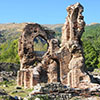Thracian rock sanctuary near the village of Nebeska
This is not the first time we visit the ancient rock sanctuary near the village of Nebeska and it will certainly not be the last. The place is magical and with an amazing view that will charge you with a lot of positive energy.
Village of Nebeska is located in Chernoochene municipality, Kardzhali district. To get there, on the road Asenovgrad - Kardzhali, from the village of Komuniga you have to stop on the road to the village of Bezvodno. The road is nice and the views are amazing. There are no signposts, but Google Maps can successfully take you to your destination. The first village you will reach is Zhenda, where you have to turn left on the first street to reach the village of Nebeska. There is about a kilometer of dirt road. At the beginning of the village there is a lot of space where you can park. From there you can see the incredible rock formations. The walk to them is light and relatively short. We walked to all the rocks and looked carefully at the rock carvings. Among them you can recognize stone mushrooms, animal figures, faces and the characteristic of the Eastern Rhodopes trapezoidal rock niches, whose purpose remains a mystery. According to one theory, the urns of burnt ordinary people are stored there. Another hypothesis is that they represent the entrance of the human soul to the afterlife.
We spent about two hours there and had a picnic in the pine grove above the rocks.
See also

Toplitsa Fortress, Mineralni Bani
Toplitsa Fortress is located on the Sveti Duh hill in the city of Mineralni Bani, Haskovo region. According to historical records, the former town of Toplicos (Toplica) was located in this area. The fortress is located in the city itself. The place around it has recently been renovated and there are many places for rest - benches and gazebos. Every Saturday a multimedia light show is organized on the eastern fortress wall, which presents its history.
Explore

































































Comments
Leave comment